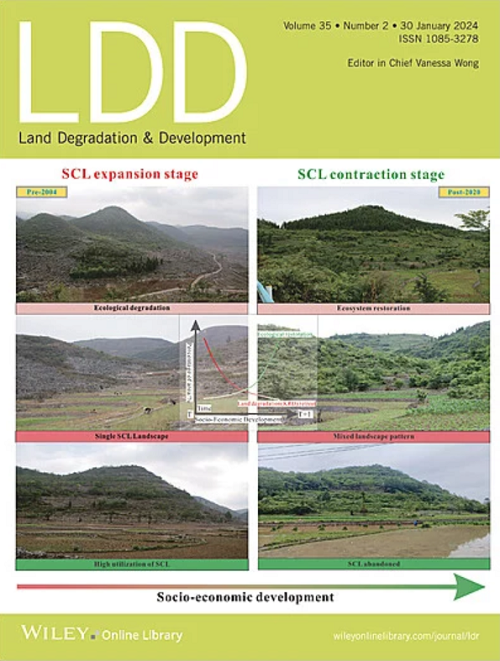Indirect Prediction Based on Machine Learning and Remote Sensing of Ecological Stoichiometric Ratio Superior to Direct Prediction
IF 3.6
2区 农林科学
Q2 ENVIRONMENTAL SCIENCES
引用次数: 0
Abstract
Exploring carbon (C), nitrogen (N), and phosphorus (P) contents as well as dynamic balances in soil are important for understanding ecological characteristics and stability. However, the substantial costs associated with soil surveys limited the possibility of large-scale surveys. The accurate predictive capability of machine learning (ML) supported this possibility. In this study, ML models (Random Forest, RF; support vector machine, SVM; Extreme Gradient Boosting, XGboost; Gradient Boosting Decision Tree, GBDT) and remote sensing data were used to predict soil C, N, and P as well as ecological stoichiometric ratio (ESR) in the Yellow River Delta (YRD). The purpose of this study was to assess the performance of four MLs in predicting soil C, N, and P as well as ESRs and to assess the performance of indirect and direct predictions in ESRs. The results showed that RF and SVM have higher accuracy than XGboost and GBDT. The model was the main factor affecting accuracy, and there were differences in the applicability of different elements to the model. The ESR prediction performance was weaker than that of total elements due to the fact that ESR is controlled by two elements. In the localized prediction of farmland and wetland vegetation, the performance of the models was substantially enhanced compared to the global prediction. The predictive performance of total elements was higher and the predictive performance of ESRs was poorer in soil in farmland. However, this pattern was reversed in wetland vegetated soil. The prediction followed by calculation method improved the prediction accuracy of ESRs. Although not generalizable, this approach still offered a possibility for accurate prediction of multi-element variables such as ESRs. Land-use type had a significant effect on soil C, N, and P as well as ESRs. The mean values of TC, TN, and TP in the study area were 17.730 ± 2.395, 0.710 ± 0.253, and 0.691 ± 0.089 g/kg, respectively. The highest TC was found in farmland and wetland vegetation soils with mean values of 18.228 and 18.138 g/kg, respectively. The Yellow River as well as its old channel had a significant effect on the spatial distribution of C, N, P, and ESRs. This study clarified the spatial distribution pattern of soil C, N, and P as well as ESR in the YRD. In addition, this study provided an indirect prediction method for the prediction of multi-element variables that improved the prediction accuracy.基于机器学习和遥感的生态化学计量比间接预测优于直接预测
研究土壤碳(C)、氮(N)和磷(P)含量及其动态平衡对了解生态特征和稳定性具有重要意义。然而,与土壤调查有关的大量费用限制了大规模调查的可能性。机器学习(ML)的准确预测能力支持了这种可能性。在本研究中,ML模型(Random Forest, RF;支持向量机;极限梯度增强,XGboost;利用梯度增强决策树(GBDT)和遥感数据对黄河三角洲土壤C、N、P和生态化学计量比(ESR)进行了预测。本研究的目的是评估4种ml在预测土壤C、N、P和esr方面的性能,并评估间接和直接预测esr的性能。结果表明,与XGboost和GBDT相比,RF和SVM具有更高的准确率。模型是影响精度的主要因素,不同要素对模型的适用性存在差异。由于ESR受两个元素的控制,因此ESR的预测效果弱于全元素的预测效果。在农田和湿地植被的局部预测中,与全球预测相比,模型的性能得到了显著提高。在农田土壤中,全元素的预测性能较高,esr的预测性能较差。而湿地植被土壤则相反。先预测后计算的方法提高了esr的预测精度。该方法虽不能推广,但仍为准确预测esr等多元素变量提供了可能。土地利用类型对土壤C、N、P和esr有显著影响。研究区TC、TN和TP的平均值分别为17.730±2.395、0.710±0.253和0.691±0.089 g/kg。农田和湿地植被土壤的TC最高,平均值分别为18.228和18.138 g/kg。黄河及其旧河道对碳、氮、磷和esr的空间分布有显著影响。本研究阐明了长三角地区土壤C、N、P和ESR的空间分布格局。此外,本研究为多元素变量的预测提供了一种间接预测方法,提高了预测精度。
本文章由计算机程序翻译,如有差异,请以英文原文为准。
求助全文
约1分钟内获得全文
求助全文
来源期刊

Land Degradation & Development
农林科学-环境科学
CiteScore
7.70
自引率
8.50%
发文量
379
审稿时长
5.5 months
期刊介绍:
Land Degradation & Development is an international journal which seeks to promote rational study of the recognition, monitoring, control and rehabilitation of degradation in terrestrial environments. The journal focuses on:
- what land degradation is;
- what causes land degradation;
- the impacts of land degradation
- the scale of land degradation;
- the history, current status or future trends of land degradation;
- avoidance, mitigation and control of land degradation;
- remedial actions to rehabilitate or restore degraded land;
- sustainable land management.
 求助内容:
求助内容: 应助结果提醒方式:
应助结果提醒方式:


